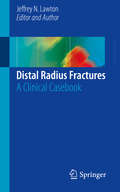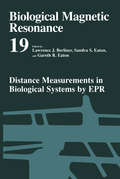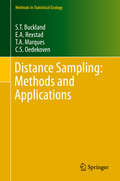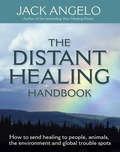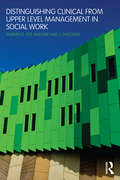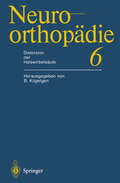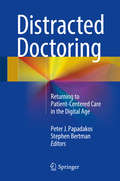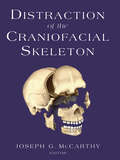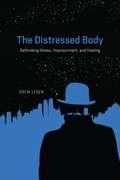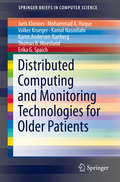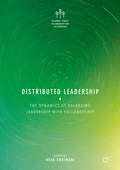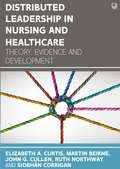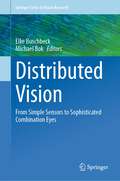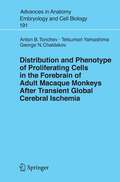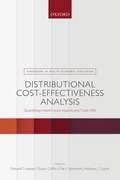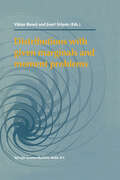- Table View
- List View
Distal Radius Fractures: A Clinical Casebook
by Jeffrey N. LawtonBased exclusively upon clinical cases covering fractures of the distal radius, this concise, practical casebook will provide orthopedic surgeons and sports medicine specialists with the best real-world strategies to properly manage the multifaceted surgical techniques for management of the distal radius and distal radial ulnar joint (DRUJ). Each chapter begins with a case that opens with a unique clinical presentation, followed by a description of the diagnosis, assessment and management techniques used to treat it, as well as the case outcome and clinical pearls and pitfalls. Cases included illustrate the various uses of the volar locking plate for metaphyseal and periarticular fractures, among others, as well as management strategies for open reduction internal fixation (ORIF) for the radial styloid. Ulnar styloid and ulnar head/neck fractures are likewise described. Pediatric distal radius fractures and complications round out the presentation. Pragmatic and reader friendly, Distal Radius Fractures: A Clinical Casebook will be an excellent resource for orthopedic surgeons, hand and upper extremity surgeons and sports medicine specialists confronted with both common and complex fractures to the distal radius and DRUJ.
Distance Measurements in Biological Systems by EPR (Biological Magnetic Resonance #19)
by Lawrence J. Berliner Gareth R. Eaton Sandra S. EatonDistance measurements in biological systems by EPR The foundation for understanding function and dynamics of biological systems is knowledge of their structure. Many experimental methodologies are used for determination of structure, each with special utility. Volumes in this series on Biological Magnetic Resonance emphasize the methods that involve magnetic resonance. This volume seeks to provide a critical evaluation of EPR methods for determining the distances between two unpaired electrons. The editors invited the authors to make this a very practical book, with specific numerical examples of how experimental data is worked up to produce a distance estimate, and realistic assessments of uncertainties and of the range of applicability, along with examples of the power of the technique to answer biological problems. The first chapter is an overview, by two of the editors, of EPR methods to determine distances, with a focus on the range of applicability. The next chapter, also by the Batons, reviews what is known about electron spin relaxation times that are needed in estimating distances between spins or in selecting appropriate temperatures for particular experiments. Albert Beth and Eric Hustedt describe the information about spin-spin interaction that one can obtain by simulating CW EPR line shapes of nitroxyl radicals. The information in fluid solution CW EPR spectra of dual-spin labeled proteins is illustrated by Hassane Mchaourab and Eduardo Perozo.
Distance Sampling: Methods and Applications (Methods in Statistical Ecology)
by S. T. Buckland E.A. Rexstad T.A. Marques C.S. OedekovenIn this book, the authors cover the basic methods and advances within distance sampling that are most valuable to practitioners and in ecology more broadly. This is the fourth book dedicated to distance sampling. In the decade since the last book published, there have been a number of new developments. The intervening years have also shown which advances are of most use. This self-contained book covers topics from the previous publications, while also including recent developments in method, software and application.Distance sampling refers to a suite of methods, including line and point transect sampling, in which animal density or abundance is estimated from a sample of distances to detected individuals. The book illustrates these methods through case studies; data sets and computer code are supplied to readers through the book’s accompanying website. Some of the case studies use the software Distance, while others use R code. The book is in three parts. The first part addresses basic methods, the design of surveys, distance sampling experiments, field methods and data issues. The second part develops a range of modelling approaches for distance sampling data. The third part describes variations in the basic method; discusses special issues that arise when sampling different taxa (songbirds, seabirds, cetaceans, primates, ungulates, butterflies, and plants); considers advances to deal with failures of the key assumptions; and provides a check-list for those conducting surveys.
The Distant Healing Handbook: How to send healing to people, animals, the environment and global trouble spots
by Jack AngeloTHE DISTANT HEALING HANDBOOK is an important book from the UK's leading healing teacher, Jack Angelo. Jack explains that we all have it in our power to take action, to reach out and help people, places and animals who are in need. Extraordinary case histories reveal the beneficial effect distant healing can have. Step-by-step, using over 60 easy-to-follow exercises, Jack shows you how to access your own distant healing power and harness your love and energy for the good of others. THE DISTANT HEALING HANDBOOK will enable you to: Sense your energy field and send healing to people at any distance; Work on your own or with a group or healing circle; Learn advanced, astral level healing; Work with the environment, plants and animals; Send light to trouble spots and disaster areas around the world; Practise unconditional love and bring healing into your everyday life. THE DISTANT HEALING HANDBOOK is a book everyone can use, whether you already have a healing gift or whether you simply want to learn how to send healing and make a difference to a loved one, a pet or to the world we live in.
Distinctiveness and Memory
by R. Reed Hunt James B. WorthenResearch relevant to the topic of distinctiveness and memory dates back over 100 years and boasts a literature of well over 2,000 published articles. Throughout this history, numerous theories of distinctiveness and memory have been offered and subsequently refined. There has, however, never been a book that brings this rich history together with the latest research. This volume is the first to present an historical overview, the results of the current research, and several new theories on distinctiveness and memory. Each chapter contains a review of the relevant literature and latest research on its topic. The book includes sections that cover basic theory and behavioral research on distinctiveness, bizarreness effects, distinctiveness effects on implicit memory, the development of distinctiveness across the lifespan, distinctiveness in social context, and the neuroscience of distinctiveness and memory. In the concluding chapter, Fergus Craik offers his current perspective on distinctiveness and evaluates the various other theories of distinctiveness presented in the volume. Distinctiveness and Memory will be a valuable resource for student and professional researchers in neuroscience and cognitive, developmental, and social psychology.
Distinguishing Clinical from Upper Level Management in Social Work
by Marvin D. Feit Michael J. HoloskoOver the past few decades, as administrative and technological complexity has increased, so has the role and importance of administrative practice in social work. For those making the switch from front-line practice to administration and management there is, therefore, a real need to prepare and enhance the knowledge base and skill set necessary at the executive level. In particular, the importance of budgeting and fiscal management, the need for accountability, negotiation between different and competing organizations, along with an understanding of decision-making, planning, and understanding levels of risk. Written by two experienced authors within social work education, this practical workbook presents the interrelated nature of decision-making, and provides a model for understanding what is required in the transition from clinician, to clinical and upper level management. The text covers: The difference between clinical and upper level management skills The major trends that influence health and human service organizations An analysis of the concept of leadership The skills needed by Clinical Managers and Upper Level Managers to administer effectively. Distinguishing Clinical and Upper Level Management is a much needed update to the field of management and administration within human service organizations, and will be important reading for social work students, social service professionals, and other human service providers.
Distinguishing Clinical from Upper Level Management in Social Work
by Marvin D. Feit Michael J. HoloskoOver the past few decades, as administrative and technological complexity has increased, so has the role and importance of administrative practice in social work. For those making the switch from front-line practice to administration and management there is, therefore, a real need to prepare and enhance the knowledge base and skill set necessary at the executive level. In particular, the importance of budgeting and fiscal management, the need for accountability, negotiation between different and competing organizations, along with an understanding of decision-making, planning, and understanding levels of risk. Written by two experienced authors within social work education, this practical workbook presents the interrelated nature of decision-making, and provides a model for understanding what is required in the transition from clinician, to clinical and upper level management. The text covers: The difference between clinical and upper level management skills The major trends that influence health and human service organizations An analysis of the concept of leadership The skills needed by Clinical Managers and Upper Level Managers to administer effectively. Distinguishing Clinical and Upper Level Management is a much needed update to the field of management and administration within human service organizations, and will be important reading for social work students, social service professionals, and other human service providers.
Distracted Doctoring: Returning to Patient-Centered Care in the Digital Age
by Peter J. Papadakos Stephen BertmanExamining-room computers require doctors to record detailed data about their patients, yet reduce the time clinicians can spend listening attentively to the very people they are trying to help. This book presents original essays by distinguished experts in their fields, addressing this critical problem and making an urgent case for reform, because while electronic technology has revolutionized the practice of medicine, it also poses a unique challenge to health care. Smartphones in the hands of doctors and nurses have become dangerously seductive devices that can endanger their patients. Distracted Doctoring is written for anesthesiologists and surgeons, as well as general practitioners, nurses, and health care administrators and students. Chapters include Electronic Challenges to Patient Safety and Care; Distraction, Disengagement, and the Purpose of Medicine; and Managing Distractions through Advocacy, Education, and Change.
Distraction of the Craniofacial Skeleton
by P. Tessier Joseph G. McCarthyDr. McCarthy and his colleagues at NYU have developed techniques of distracting various components of the craniofacial skeleton. These techniques hold considerable promise for reconstructive surgery, allowing the surgeon to make precise changes in the lengthening and shape of the new craniofacial bone. This is the first volume of its kind, bringing together the pioneers of these revolutionary techniques: an international group of experts present their clinical and laboratory experience with distraction of the cranial vault, orbit, midface and zygoma, and mandible, as well as the principles of distraction, biomechanics, and the physiology of bone healing and remodelling. With two hundred illustrations, this is a must for all reconstructive plastic, maxillofacial, and oral surgeons.
The Distressed Body: Rethinking Illness, Imprisonment, and Healing
by Drew LederBodily pain and distress come in many forms. They can well up from within at times of serious illness, but the body can also be subjected to harsh treatment from outside. The medical system is often cold and depersonalized, and much worse are conditions experienced by prisoners in our age of mass incarceration, and by animals trapped in our factory farms. In this pioneering book, Drew Leder offers bold new ways to rethink how we create and treat distress, clearing the way for more humane social practices. Leder draws on literary examples, clinical and philosophical sources, his medical training, and his own struggle with chronic pain. He levies a challenge to the capitalist and Cartesian models that rule modern medicine. Similarly, he looks at the root paradigms of our penitentiary and factory farm systems and the way these produce distressed bodies, asking how such institutions can be reformed. Writing with coauthors ranging from a prominent cardiologist to long-term inmates, he explores alternative environments that can better humanize—even spiritualize—the way we treat one another, offering a very different vision of medical, criminal justice, and food systems. Ultimately Leder proposes not just new answers to important bioethical questions but new ways of questioning accepted concepts and practices.
The Distressed Body: Rethinking Illness, Imprisonment, and Healing
by Drew LederBodily pain and distress come in many forms. They can well up from within at times of serious illness, but the body can also be subjected to harsh treatment from outside. The medical system is often cold and depersonalized, and much worse are conditions experienced by prisoners in our age of mass incarceration, and by animals trapped in our factory farms. In this pioneering book, Drew Leder offers bold new ways to rethink how we create and treat distress, clearing the way for more humane social practices. Leder draws on literary examples, clinical and philosophical sources, his medical training, and his own struggle with chronic pain. He levies a challenge to the capitalist and Cartesian models that rule modern medicine. Similarly, he looks at the root paradigms of our penitentiary and factory farm systems and the way these produce distressed bodies, asking how such institutions can be reformed. Writing with coauthors ranging from a prominent cardiologist to long-term inmates, he explores alternative environments that can better humanize—even spiritualize—the way we treat one another, offering a very different vision of medical, criminal justice, and food systems. Ultimately Leder proposes not just new answers to important bioethical questions but new ways of questioning accepted concepts and practices.
The Distressed Body: Rethinking Illness, Imprisonment, and Healing
by Drew LederBodily pain and distress come in many forms. They can well up from within at times of serious illness, but the body can also be subjected to harsh treatment from outside. The medical system is often cold and depersonalized, and much worse are conditions experienced by prisoners in our age of mass incarceration, and by animals trapped in our factory farms. In this pioneering book, Drew Leder offers bold new ways to rethink how we create and treat distress, clearing the way for more humane social practices. Leder draws on literary examples, clinical and philosophical sources, his medical training, and his own struggle with chronic pain. He levies a challenge to the capitalist and Cartesian models that rule modern medicine. Similarly, he looks at the root paradigms of our penitentiary and factory farm systems and the way these produce distressed bodies, asking how such institutions can be reformed. Writing with coauthors ranging from a prominent cardiologist to long-term inmates, he explores alternative environments that can better humanize—even spiritualize—the way we treat one another, offering a very different vision of medical, criminal justice, and food systems. Ultimately Leder proposes not just new answers to important bioethical questions but new ways of questioning accepted concepts and practices.
The Distressed Body: Rethinking Illness, Imprisonment, and Healing
by Drew LederBodily pain and distress come in many forms. They can well up from within at times of serious illness, but the body can also be subjected to harsh treatment from outside. The medical system is often cold and depersonalized, and much worse are conditions experienced by prisoners in our age of mass incarceration, and by animals trapped in our factory farms. In this pioneering book, Drew Leder offers bold new ways to rethink how we create and treat distress, clearing the way for more humane social practices. Leder draws on literary examples, clinical and philosophical sources, his medical training, and his own struggle with chronic pain. He levies a challenge to the capitalist and Cartesian models that rule modern medicine. Similarly, he looks at the root paradigms of our penitentiary and factory farm systems and the way these produce distressed bodies, asking how such institutions can be reformed. Writing with coauthors ranging from a prominent cardiologist to long-term inmates, he explores alternative environments that can better humanize—even spiritualize—the way we treat one another, offering a very different vision of medical, criminal justice, and food systems. Ultimately Leder proposes not just new answers to important bioethical questions but new ways of questioning accepted concepts and practices.
The Distressed Body: Rethinking Illness, Imprisonment, and Healing
by Drew LederBodily pain and distress come in many forms. They can well up from within at times of serious illness, but the body can also be subjected to harsh treatment from outside. The medical system is often cold and depersonalized, and much worse are conditions experienced by prisoners in our age of mass incarceration, and by animals trapped in our factory farms. In this pioneering book, Drew Leder offers bold new ways to rethink how we create and treat distress, clearing the way for more humane social practices. Leder draws on literary examples, clinical and philosophical sources, his medical training, and his own struggle with chronic pain. He levies a challenge to the capitalist and Cartesian models that rule modern medicine. Similarly, he looks at the root paradigms of our penitentiary and factory farm systems and the way these produce distressed bodies, asking how such institutions can be reformed. Writing with coauthors ranging from a prominent cardiologist to long-term inmates, he explores alternative environments that can better humanize—even spiritualize—the way we treat one another, offering a very different vision of medical, criminal justice, and food systems. Ultimately Leder proposes not just new answers to important bioethical questions but new ways of questioning accepted concepts and practices.
The Distressed Body: Rethinking Illness, Imprisonment, and Healing
by Drew LederBodily pain and distress come in many forms. They can well up from within at times of serious illness, but the body can also be subjected to harsh treatment from outside. The medical system is often cold and depersonalized, and much worse are conditions experienced by prisoners in our age of mass incarceration, and by animals trapped in our factory farms. In this pioneering book, Drew Leder offers bold new ways to rethink how we create and treat distress, clearing the way for more humane social practices. Leder draws on literary examples, clinical and philosophical sources, his medical training, and his own struggle with chronic pain. He levies a challenge to the capitalist and Cartesian models that rule modern medicine. Similarly, he looks at the root paradigms of our penitentiary and factory farm systems and the way these produce distressed bodies, asking how such institutions can be reformed. Writing with coauthors ranging from a prominent cardiologist to long-term inmates, he explores alternative environments that can better humanize—even spiritualize—the way we treat one another, offering a very different vision of medical, criminal justice, and food systems. Ultimately Leder proposes not just new answers to important bioethical questions but new ways of questioning accepted concepts and practices.
Distributed Computing and Monitoring Technologies for Older Patients (SpringerBriefs in Computer Science)
by Juris Klonovs Mohammad Ahsanul Haque Volker Krüger Kamal Nasrollahi Karen Andersen-Ranberg Thomas B. Moeslund Erika Geraldina SpaichThis book summarizes various approaches for the automatic detection of health threats to older patients at home living alone. The text begins by briefly describing those who would most benefit from healthcare supervision. The book then summarizes possible scenarios for monitoring an older patient at home, deriving the common functional requirements for monitoring technology. Next, the work identifies the state of the art of technological monitoring approaches that are practically applicable to geriatric patients. A survey is presented on a range of such interdisciplinary fields as smart homes, telemonitoring, ambient intelligence, ambient assisted living, gerontechnology, and aging-in-place technology. The book discusses relevant experimental studies, highlighting the application of sensor fusion, signal processing and machine learning techniques. Finally, the text discusses future challenges, offering a number of suggestions for further research directions.
Distributed Leadership: The Dynamics of Balancing Leadership with Followership
by Neha ChatwaniAddressing the area of shared leadership, also known as collective or distributed leadership, this edited book embraces the underlying idea that leadership is a dynamic process that intersects closely with followership. While some authors present rigorously researched qualitative and quantitative case studies that investigate the dynamics of followership in distributive leadership in terms of collective decision-making, leadership identity, roles and demographic composition of groups in a variety of settings, other authors take a critical look at distributed leadership models by viewing them through the lens of nature and ecosystems as well as human development processes. The chapters aim to inspire readers to challenge the current definition of leadership and explore more inclusive and holistic paradigms. Distributed Leadership provides a comprehensive and constructive contribution to the field of leadership and will be an essential read for academics and scholar-practitioners interested in business management.
Distributed Leadership: The Dynamics of Balancing Leadership with Followership
by Neha ChatwaniAddressing the area of shared leadership, also known as collective or distributed leadership, this edited book embraces the underlying idea that leadership is a dynamic process that intersects closely with followership. While some authors present rigorously researched qualitative and quantitative case studies that investigate the dynamics of followership in distributive leadership in terms of collective decision-making, leadership identity, roles and demographic composition of groups in a variety of settings, other authors take a critical look at distributed leadership models by viewing them through the lens of nature and ecosystems as well as human development processes. The chapters aim to inspire readers to challenge the current definition of leadership and explore more inclusive and holistic paradigms. Distributed Leadership provides a comprehensive and constructive contribution to the field of leadership and will be an essential read for academics and scholar-practitioners interested in business management.
Distributed Leadership in Nursing and Healthcare: Theory, Evidence and Development
by John Cullen Ruth Northway Elizabeth A. Curtis Martin Beirne Siobhan Corrigan“This book claims to be ‘like no other’ and that is so true. The editors and authors each add quality guidance around distributed leadership to readers, providing evidence-based examples, useful websites and key reading material to support and supplement the ideas being presented.”Bridie Kent, Professor in Leadership in Nursing, University of Plymouth, UK “This book, thankfully, isn’t about self-defined heroic organizational leaders or power-hungry political leaders – it tells the stories of the people doing leadership every day in their work to make healthcare happen.”Scott Taylor, Business School Director of Admissions, University of Birmingham, UK This innovative book brings together experts from health sciences, nursing, business and management backgrounds to provide a broad analysis of the growing field of distributed leadership. The book offers health professionals practical guidance on applying distributed leadership, resulting in more effective forms of collaborative clinical teamwork and lasting improvements in care. The text: •Offers a comprehensive collection of perspectives, featuring chapters by expert clinical, nursing and management studies contributors•Synthesizes and explores recent developments in the leadership and distributed leadership research literature•Supports research and theory with examples of cases of effective distributed leadership in clinical practice, service quality, patient safety, leadership development, general nursing, midwifery education, oncology services, intellectual disability, evidence-based practice and organizational change and development•Provides an international focus, to encourage reflection on learning from experiences across Europe and beyondDistributed Leadership in Nursing and Healthcare is essential reading for health professionals, undergraduate and postgraduate students, and researchers working in the field of leadership. Edited by:Elizabeth A. Curtis, Assistant Professor, Trinity College Dublin, IrelandMartin Beirne, Emeritus Professor of Management and Organisational Behaviour at the University of Glasgow, UKJohn G. Cullen, Associate Professor, Maynooth University, IrelandRuth Northway, Professor of Learning Disability Nursing, University of South Wales, UKSiobhán M. Corrigan, Assistant Professor, Trinity College Dublin, Ireland
Distributed Vision: From Simple Sensors to Sophisticated Combination Eyes (Springer Series in Vision Research)
by Elke Buschbeck Michael BokThis volume explores the diversity of distributed eyes and other unusual visual systems in nature. It compares the unique themes of optics, neural processing, and behavioral control that emerge from these visual systems with more-canonical eyes. This volume attempts to answer a number of questions about distributed visual systems. What are distributed visual systems good for, how do they function, and why have they arisen independently in so many phyla? Why are eye designs and visual system arrangements much more diverse in invertebrates? Each chapter includes an overview of the visual systems that exist in their group of animals, relates vision to ecology, and takes a comparative approach.
Distribution and Phenotype of Proliferating Cells in the Forebrain of Adult Macaque Monkeys after Transient Global Cerebral Ischemia (Advances in Anatomy, Embryology and Cell Biology #191)
by A.B. Tonchev T. Yamashima G.N. ChaldakovThe authors' results show that ischemia differentially activates endogenous neural precursors residing in diverse locations of the adult primate central nervous system. A limited endogenous potential for postischemic neuronal repair exists in neocortex and striatum, but not in the hippocampus proper of the adult macaque monkey brain. The presence of putative parenchymal progenitors and of sustained progenitors in germinative centers opens novel possibilities for precursor cell recruitment.
Distributional Cost-Effectiveness Analysis: Quantifying Health Equity Impacts and Trade-Offs (Handbooks in Health Economic Evaluation)
by Richard Cookson, Susan Griffin, Ole F. Norheim and Anthony J. CulyerDistributional cost-effectiveness analysis aims to help health care and public health organisations make fairer decisions with better outcomes. Whereas standard cost-effectiveness analysis provides information about total costs and effects, distributional cost-effectiveness analysis provides additional information about fairness in the distribution of costs and effects - who gains, who loses, and by how much. It can also provide information about the trade-offs that sometimes occur between efficiency objectives, such as improving total health, and equity objectives, such as reducing unfair inequality in health. This is a practical guide to a flexible suite of economic methods for quantifying the equity consequences of health programmes in high-, middle- and low-income countries. The methods can be tailored and combined in various ways to provide useful information to different decision-makers in different countries with different distributional equity concerns. The handbook is primarily aimed at postgraduate students and analysts specialising in cost-effectiveness analysis but is also accessible to a broader audience of health sector academics, practitioners, managers, policymakers and stakeholders. As well as offering an overview for research commissioners, users, and producers, the book includes systematic technical guidance on how to simulate and evaluate distributions, with accompanying hands-on spreadsheet training exercises, and discussions about how to handle uncertainty about facts and disagreement about values, and the future challenges facing this young and rapidly evolving field of study.
Distributional Cost-Effectiveness Analysis: Quantifying Health Equity Impacts and Trade-Offs (Handbooks in Health Economic Evaluation)
Distributional cost-effectiveness analysis aims to help health care and public health organisations make fairer decisions with better outcomes. Whereas standard cost-effectiveness analysis provides information about total costs and effects, distributional cost-effectiveness analysis provides additional information about fairness in the distribution of costs and effects - who gains, who loses, and by how much. It can also provide information about the trade-offs that sometimes occur between efficiency objectives, such as improving total health, and equity objectives, such as reducing unfair inequality in health. This is a practical guide to a flexible suite of economic methods for quantifying the equity consequences of health programmes in high-, middle- and low-income countries. The methods can be tailored and combined in various ways to provide useful information to different decision-makers in different countries with different distributional equity concerns. The handbook is primarily aimed at postgraduate students and analysts specialising in cost-effectiveness analysis but is also accessible to a broader audience of health sector academics, practitioners, managers, policymakers and stakeholders. As well as offering an overview for research commissioners, users, and producers, the book includes systematic technical guidance on how to simulate and evaluate distributions, with accompanying hands-on spreadsheet training exercises, and discussions about how to handle uncertainty about facts and disagreement about values, and the future challenges facing this young and rapidly evolving field of study.
Distributions with given Marginals and Moment Problems
by Viktor Benes Josef StepánThe last decade has seen a remarkable development of the "Marginal and Moment Problems" as a research area in Probability and Statistics. Its attractiveness stemmed from its lasting ability to provide a researcher with difficult theoretical problems that have direct consequences for appli cations outside of mathematics. The relevant research aims centered mainly along the following lines that very frequently met each other to provide sur prizing and useful results : -To construct a probability distribution (to prove its existence, at least) with a given support and with some additional inner stochastic property defined typically either by moments or by marginal distributions. -To study the geometrical and topological structure of the set of prob ability distributions generated by such a property mostly with the aim to propose a procedure that would result in a stochastic model with some optimal properties within the set of probability distributions. These research aims characterize also, though only very generally, the scientific program of the 1996 conference "Distributions with given marginals and moment problems" held at the beginning of September in Prague, Czech Republic, to perpetuate the tradition and achievements of the closely related 1990 Roma symposium "On Frechet Classes" 1 and 1993 Seattle" AMS Summer Conference on Marginal Problem".
